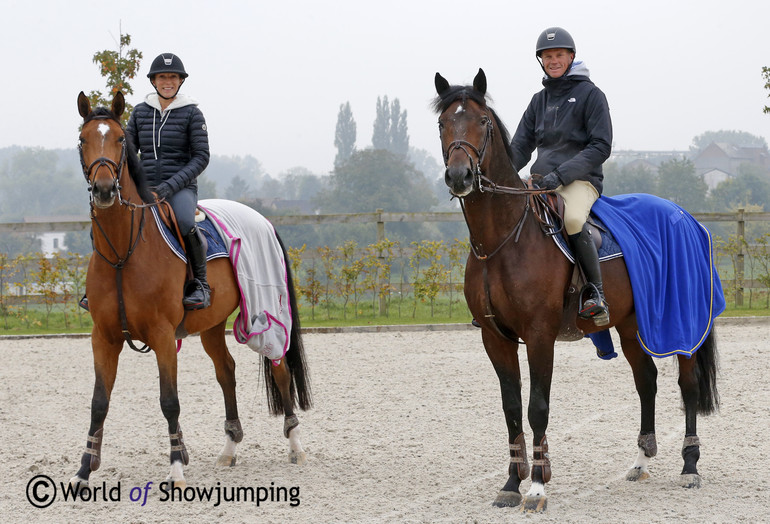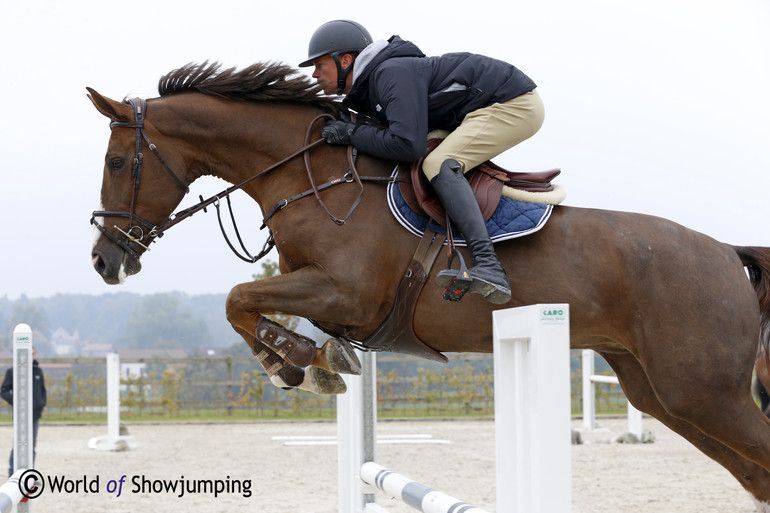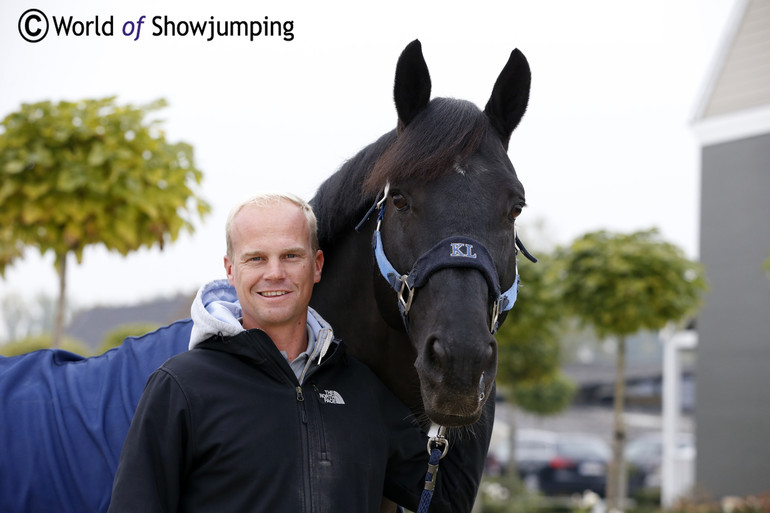Belgian rider Jerome Guery can certainly never be accused for doing things the easy way. The now 35-year-old has managed to climb to the highest level of the sport by his own hard work, and without big sponsors or wealthy horse owners. Now, he finds himself owning a hugely successful business with his wife Patricia, having a network of partners and breeders supporting him with horses in return for the work he puts into them, as well as looking towards the future with a string of horses most would envy him. And most importantly, as Guery says; "Now I am happy!”
Meet Belgium’s fair-haired wonder boy, one of those with the biggest smiles on the circuit - but as we discover, also a very determined rider with a will to follow his own ways.
Guery comes from a family that had nothing to do with horses. Jerome's mother worked as a teacher, and his father in publicity. When he was 10, Guery started to ride at his local pony club - and was quickly bitten by the bug. "Directly it was a click for me with the horses,” Guery says. “After a year I started staying at the club during my holidays - I put my tent in the garden of the guy who owned the stables,” he says making us laugh at the thought of his camping life. "It was a passion straight away!”
With a son so interested, Jerome’s mother quickly realised that this was serious. “My mother then helped me to buy a pony. We did not have a lot of money, but she managed to collect enough. I understood immediately that in order to later on buy a new horse, I would have to make something good out of the first pony so we would be left with a profit,” Guery says while quickly throwing in on our remark - that yes, he indeed learned the name of the game early on. As it usually goes, after three years the pony was too small and had to be sold - and as planned with profit after jumping internationally. “From this profit we could buy a good horse,” Jerome says. "Still, I thought it was hard to sell the pony of course - but it was also out of respect for my parents that I did it this way. Then they could see that I understood the value of it all."
Another two years passed, and Jerome was competing successfully on the international junior circuit. It was time to get even more serious. "At this time I was 16, and I started to ride after school for a breeder. I had only one horse, and I needed more horses to get experience - and this was my chance. While I was there I got to ride a mare that proved to be really good, so after selling my other horse I asked my mum if we could buy it and so we did. I went on to win the Belgian junior championship with her,” Jerome says.
That kicked off the decision to do horses full-time. Guery’s parents agreed on a one-year-break before deciding on going to university, and as we all know by now - the university never happened. "I started to work at Haras des Hayettes when I was 18 and stayed until I was 20. It was a great experience; they had good horses such as Mozart des Hayettes and Lady des Hayettes - they were young back then, but still really good."
At this time Jerome also met the woman who would later become his wife; Patricia. "We quickly decided to start a stable together. It was not so easy in the beginning I have to say. We had no money, and not really any good horses - but my luck was that I straight away started to work with the Belgian breeder Luc Henry. Like me he was young, ambitious and we began a collaboration - working with his youngsters, selling them and reinvesting. It has lasted all the way until today, and by now he is one of my most important business partners as well as one of my best friends."
It was a horse from Stal de Kalvarie that would give Guery his international breakthrough though. Waldo came to Jerome when he was eight, and would be the one that made the Belgian rider knock on the door so hard it opened. "Most of the times when a horse comes to my stable it is to sell, and it was the same with Waldo. But in this case, Luc Henry and I decided to invest in the horse ourselves. I felt it was a super horse with something special. I believed that this time I had a horse for the top sport, and it had always been my dream to compete at a higher level,” Jerome says looking back. “With Waldo I got to compete at big shows such as La Baule, St. Gallen and Falsterbo - for me it was like a dream of course. My sport career finally started, at the age of 27."
There is a saying that patience is a conquering virtue. Never was it more right than in Guery’s case. But it was a long wait, and sometimes a hard wait, to reach the level he wanted to be at. "When I was a junior and young rider I competed at the international shows with riders like Steve Guerdat and Kevin Staut - but I chose a completely different way to the top sport than they did. In the beginning it was hard to watch; they were doing so good all the way up there. But I knew it was my choice to do it differently, and now I am very happy about it."
After selling Waldo the year he had turned twelve, Jerome was determined to try to keep himself in the top sport. “At this point Upper Star was in my place, and it was with him that I was able to continue at the level I was at. Tic Tac du Seigneur was also here; in my plans he would be the one to follow Upper. But, then Tic Tac won the Belgian Championships and we received an offer that we could not refuse. I have to pay my costs every month out of my own pocket, and the sale made that a lot easier and it also gave us a lot of economical freedom to invest in our stable and in new horses,” Jerome explains.
Upper Star lived up to the expectations, and after jumping successfully in Aachen and Gijon during the summer of 2013 he was - like most horses in Guery’s stable - sold. Luciana Diniz was the one to take over the reins. She is not the only good rider Guery has sold a horse to, plenty of professionals come to Jerome’s stable to search for their next super star. Leslie Howard bought Tic Tac from Guery, and Lucy Davis V Pleasure - now known as Curtis, the full brother of her top horse Barron.
So, what is the secret to finding all these super stars and bringing them all the way up to the top level of the sport? "I work closely with some of the best breeders here in Belgium, like Luc Henry from Stud Hero and Marc Vanlangendonck from Elevage du Seigneur. We have a great partnership and a great friendship. They also get me as a person and how I work; I like to be independent and I don’t like to be controlled into detail - I prefer to do things my way. Maybe I make mistakes sometimes, but then I learn from them,” Guery smiles.
When searching among the youngest horses, Jerome tend to look to their mother lines - and of course how they free jump. "I always look for a good mother line, that is important for me. Right now, I have a daughter of Flora de Mariposa - Ilena de Mariposa and then there is the son of of Cella - Handor van’t Roosakker. I also have Kheros van’t Hoogeinde, a son of Geena van’t Roosakker. I feel that they all have the qualities to become super stars,” Guery says.
Guery prefers horses with blood that are careful - and with a good mind - over scope. "The scope is not the first thing I look for, I think I can bring that into them if they have those other qualities. Also, the sport has changed - I don’t think the horses need all the scope in the world anymore to succeed. But I don’t have a specific type; it’s more the energy I feel in each horse."
“The most important thing with young horses is to take it step by step, and not to go to quick - make sure you don’t burn them out. With young horses it goes up and down, so as a rider you have to be patient - although I find myself in situations where my wife has to remind me about it. A horse’s development is slow, this you always have to remember in the process with youngsters. That is the best possible opportunity you can give them to succeed,” Guery says.
There are not only young horses in Guery’s stable though. This year the Belgian rider has had huge success on two more grown-up stallions; Zojasper and Papillon Z. "Tal Milstein sent me Zojasper last year, of course with the aim of selling. He won a lot this year, and now he has been sold to Brazil. Tal and I also invested in a few horses together, like Famoso d’Ive that we recently sold as well. We have Strangelove Ennemmel together, a good 9-year-old."
Papillon Z also came from his owners to sell, but the plans changed along the way - “Now he stays for the sport unless something special happens. Normally I don’t have horses not for sale, so it is a strange feeling,” Guery laughs. When Papillon was six he went to Rik Hemeryck, and then on to Gregory Wathelet. This year, Guery got the offer to ride the horse - and Papillon straight away got the position as number one in the stable going on to win the CSI5* Grand Prix classes in Lummen and Knokke, as well as the CSI4* Grand Prix in Mons. “We definitely clicked from the beginning. And I think he felt his importance here, because he really has jumped incredible for me this summer.”
Guery certainly seems to get the best out of his four-legged partners, something that looks to be the result of Jerome’s wish to respect and understand each horse as an individual. "All the good horses are a bit special,” Jerome says. "It’s important to understand each of them to get the best of them. I think my advantage is that I rode so many different horses that by now I quickly get the feel of what a horse that comes new in the stable needs. If they feel good they will give you more, that is what I believe. In order to be a good horse man you need this experience and understanding for a horse. I think that is what separates being a real horseman from being ‘just’ a rider."
Jerome’s journey to the top might have been a bit rough at times, but now he feels that he has arrived. “I feel I am in my place now,” he smiles. "I have a beautiful family, my own stables, a lovely home and great horses. But, it was difficult to have ambitions and not do the top sport while so many of my friends where competing on top level and doing so good. I chose a different route to the highest level of the sport, but now I am glad I did.”
What Guery appreciates most is his independency. "I like to follow my own way, and have people around me believing in how I am doing it. I knew it was not for me to work for somebody else just to reach the top sport, and now I got there on my own premises. I followed what I felt. That’s perhaps my best advise to young and talented riders looking to reach higher: Do what is the best for yourself. Listen to those that belive in you, and not to the rest!"
Photos by Jenny Abrahamsson / text by Jannicke Naustdal - copyright © worldofshowjumping.com 2015.












